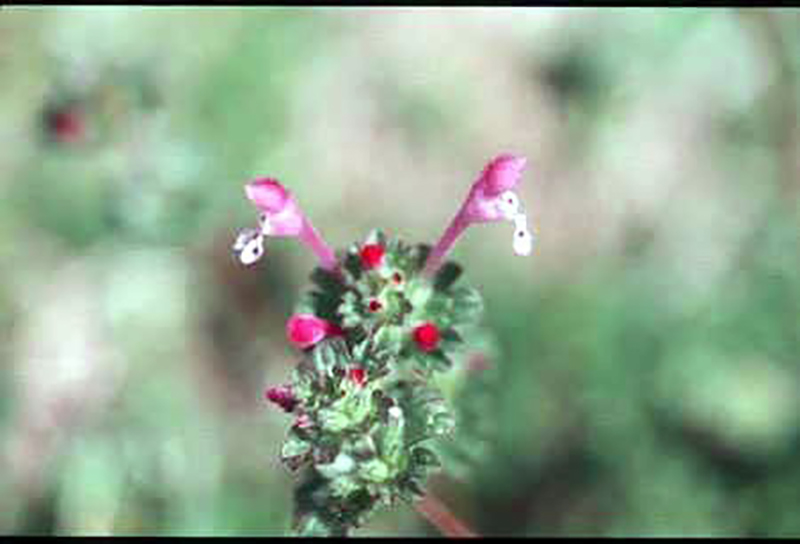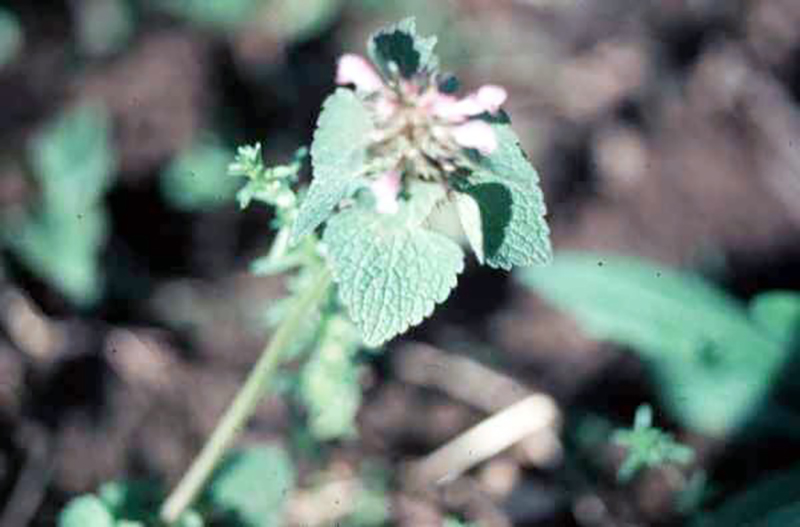picture of the week
March 13, 2023
Purple, Yellow, and White
Marcelo Zimmer, Weed Science Program Specialist
Department of Botany and Plant Pathology, Purdue University
Spring has often been associated with March Madness, but to a weed scientist and many producers, the start of the season and the warmer temperatures are celebrated with the colors purple, yellow, and white. These are the colors of the flowers of several winter annual weeds that can bloom in the spring. Below are some of the winter annual weeds that can be found broken out by flower color:
PURPLE
Purple flowers can be seen on two of the most notorious winter annual weeds in Indiana. Henbit (Lamium amplexicaule) and purple deadnettle (Lamium purpureum) (figure 1 and 2). These closely related plants are often mistaken for one another. They are both mints, so they have the characteristic square stems. They both are low lying plants not getting much taller than 10 inches. The trick to telling the two plants apart is by looking at the leaves in the upper portions of the stem. Towards the top of the stem the leaves will be attached directly to the stem in henbit. In purple deadnettle, the upper leaves will have short petioles.
Control: Henbit and purple deadnettle can be controlled with fall applications of 2,4-D tank-mixtures with products such as Roundup PowerMax III (glyphosate), Tricor (metribuzin), Princep (simazine), Basis (rimsulfuron + thifensulfuron methyl), and Canopy EX (chlorimuron + tribenuron). The choice of residual herbicide will depend on the crop to be planted next spring (corn or soybean). Purple deadnettle does not respond well to 2,4-D alone.
Click images to enlarge
YELLOW
Cressleaf groundsel (Packera glabella) is often mistaken for a mustard due to its prominent yellow flowers and pinnately divided leaves (figure 3). However, at closer inspection, it is actually a composite. This annual can paint a field yellow. Mustards, such as wild mustard (Sinapis arvensis) and yellow rocket (Barbarea vulgaris) also have yellow flowers, but with close inspection, these flowers only appear to have 4 petal-looking sepals. Cressleaf groundsel has hollow stems that can get 1 to 3 feet tall. Its 6 to 12 petal-looking ray flowers distinguish it from being a mustard. Cressleaf groundsel belongs to a group of plants that are considered toxic to cattle and horses. The toxic compounds in Senecio species causes "seneciosis" or "pictou desiease", due to liver damage. The highest concentration of toxins occurs when the plant is bud to flower. Fortunately, cressleaf groundsel is not very palatable and under typical grazing conditions, it is unlikely that animals will consume significant amounts to cause poisoning. The toxins are still present in the making of hay.
Control: Mowing can reduce cressleaf groundsel infestations by reducing seed production. Mow in the spring from bud to flower. Applications of 2,4-D (1 qt/A) can be effective in grass pastures when plants are small in the fall (October to early November) or spring (March to early April). Add a dicamba product to the 2,4-D if plants are larger. Desirable legumes will be damaged or killed.
Glyphosate plus 2,4-D can be used in corn and soybeans during late October to early November. Follow preplant intervals if 2,4-D is used before planting soybean in the spring.
 Figure 3. Cressleaf groundsel flowers and hollow stem.
Figure 3. Cressleaf groundsel flowers and hollow stem. WHITE
Shepherd's-purse (Capsella bursa-pastoris) is a mustard with a white flower (Figure 4). Similar to the mustards mentioned above, basal leaves are highly lobed forming a rosette. In the spring once shepherd's-purse starts to bloom you will see tiny white flowers with the characteristic four petal-looking sepals. The pods are triangular in shape, giving it its common name "Shepherd's-purse".
Control: Shepherd's-purse response to herbicides is similar to the mustards. Many of the herbicides labeled for fall or spring applications are effective on mustards or shepherd's-purse.
Common chickweed (Stellaria media) also has tiny white flowers and is no stranger to Indiana (Figure 5). This annual can form a low lying green mat in fields or can be seen in the edges of the grass in our lawns. Stems can reach up as high as 16 inches. Leaves are light green, simple, ovate to broadly elliptic that come to a point. The leaves are between 2/10 to almost an inch long and 1/10 to almost 1/2 inch wide. The flowers appear to have ten petals, but the ten petals are actually 5 petals that are deeply lobed.
Control: Common chickweed can be controlled with fall applications of 2,4-D tank-mixtures with products such as Roundup PowerMax III (glyphosate), Tricor (metribuzin), Princep (simazine), Basis (rimsulfuron + thifensulfuron methyl), and Canopy EX (chlorimuron + tribenuron). The choice of residual herbicide will depend on the crop to be planted next spring (corn or soybean).
Star-of-Bethlehem (Ornithogalum umbellatum) can form dense mats of dark green narrow linear leaves in the Southern portion of the state (Figure 6). Often a problem in lawns; however, it can also be seen in row crop fields. At first glance, this plant might be mistaken as a thick grass. But in actuality, this plant belongs to the lily family. If you dig Star-of-Bethlehem up you will see that it arises from many bulbs.
Control: Star-of-Bethlehem is known for being non-responsive to several herbicides. In Indiana it is often a problem in no-till fields where tillage is not an option. Gramoxone applications at 3 pt/A provides the greatest control during the current season and also reduces the density of bulbs the following spring. A few other products such as Valor, Authority, and glyphosate can provide vegetative burndown control and suppress Star-of-Bethlehem during the current season, although density of bulbs is not reduced the following spring.






